
| Freda M. Himmelmann A 20' 11' Banks dory By William & John Atkin |
| A Small Boat with a Long Name | |
| For some time past an unusual number of letters inquiring about stock plans of old-fashioned fishing dories -- the kind which have been used for many generations Down East -- have come our way. Voyaging anywhere along the coast line of Maine and over the border into Nova Scotia one sees in every harbor dozens of these excellent craft. They are as much of the seascape and foreshore as the sea gulls, lobster pots, drying fish nets, and pine trees. They are boats of excellent reputation, so much so that letters concerning their use in other than Down East waters come from unexpected places. | |

| |
Freda has an overall length of 20 feet 11 inches; a bottom length of 16 feet; a breadth of 5 feet 7 1/2 inches; and a draft of 5 1/2 inches. At the bow her freeboard is 3 feet 1/2 inch; the lowest freeboard is 1 foot 7 inches; and at the stern 2 feet 8 1/2 inches. The length of her flat keel is 16 feet and its greatest breadth is 3 feet 2 inches. The deck arrangement shows three thwarts correctly spaced for rowing with either one or two oarsmen. In the nested dories the thwarts are removable; thus one hull will fit inside another, taking up a minimum of deck space. Floor gratings or foot boards are not needed, and only contribute to the work of finishing the boat. White oak thole pins are shown on the plans. These, however, may be replaced by galvanized iron oar locks. The thole pins have the advantage of not wearing the looms of the oars. Thole pins cost much less than oars, a consideration for the thrifty-minded, and have the advantage of greater silence in rowing than metal oar locks. Take your choice. Shipmates. | |

| |
It may be of interest to mention that the lines of Freda M. Himmelmann were taken from a genuine older-day dory built by George W. Bachman of Shelbourne, Nova Scotia. Like the clipper ships of a hundred years ago the fisherman's dory has reached a point where it cannot be much improved; therefore in design and construction these boats are today much as they were in the days of square sails and hard-driving captains. Of few things made by man can this be said. The latest of the family is a rowing boat; however the flat bottom of the dory lends itself very well to the fitting of a well through which the power of a small outboard motor may easily be used. Dories are fair-lined craft and small power will give a boat of this type a comfortable speed of between six and seven miles an hour. Drawings for an outboard well are included with the plans for Freda M. Himmelmann. The name of this month's design comes from the days of the Grand Banks fishing schooners and is wrapped in the mists and tangs of the offshore sea; not only of the occupation of fishing but the lighter pastime of racing among the faster boats of the fishing fleet. The first race for the International Trophy was held off Halifax on October 20, 1920. Prior to this match, however, it was necessary to hold elimination races, for the elite of the Nova Scotia fleet. In this trial race no less than eight able little ships competed in a twenty-knot breeze over a thirty-mile course. Looking over the entry list of that October day I must say fishermen have a particular capacity for choosing names for boats. Here is the list: Delawana, Gilbert B. Waters, Alcala, Bernice Zinck, Mona Marie, Freda M. Himmelmann, Ruby L. Pentz, and Independence. For our dory design the longest of these names well fits the capacity of the little boat whose design is published this month. | |
 PHOTOS OF FREDA M. HIMMELMANN PHOTOS OF FREDA M. HIMMELMANN 
| |
| Plans for Freda M. Himmelmann are $100 MYSTIC SEAPORT MUSEUM SHIPS PLANS STORE https://store.mysticseaport.org/ships-plans/ shipsplanstore@mysticseaport.org
+1 (860) 572 5360 | |
| BACK TO PLAN LIST | |